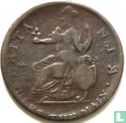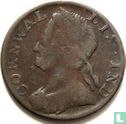



Catalogue information
Unlike other counterfeits, where the goal is to produce coins indistinguishable for the government issue coins, the 18th Century “Evasion” tokens are intentionally not too close to the exact government coinage, so as to evade counterfeiting law. They were, in fact, as close to the original coin as the counterfeiter could make them in the hope that they would not be detected as counterfeit and be readily accepted by the public. By 1753 it was estimated that no more than 2 / 5ths of the coins in circulation were genuine. This practice came to a halt with the passage of laws making the manufacture and passing of counterfeits a prison offense. By 1771, the already acute problem was out of hand, and Magistrates were empowered to order searches, and to destroy coining machinery. The laws, however, had a loophole. The laws were written to cover Regal coinage. If a coin was made that was not an EXACT COPY of the Regal coin, it was considered to be a token, and the law did not apply. Thus, the counterfeiters simply switched from making counterfeit coins to making “Evasion” token coinage that looked somewhat like the regal coin. These pieces usually had a bust on the obverse - often a likeness of King George III, or some other well known figure - and a seated Britannia or a harp (for Ireland) on the reverse. The legends were often nonsense. Instead of “George III Rex,” the obverse might have “George Rules,” “George Reigns” or “George Sus-Sex”. Other obverses treated with other personalities, such as “Glorivs Jer-Vis” or “Cornwal Lis - Ind.” The reverse legend on a good coin is "Britannia." The evasion token might say "Briton's Happy Isles," "Bonney Girls" or "Bater Sea." Humor was often seen - one of my favorite reverse legends is "Hila-rias." The makers of these lightweight pieces did not worry about being caught - there was little the government could do. The laws of the land did not cover "Evasions." The public accepted them for a variety of reasons. First and foremost, there was a need for small change. Second, the average provincial Briton could not read, and if the coin offered looked SOMEWHAT like the coin they were used to, it would be accepted. The use of these coppers were of a decided disadvantage to the end user. There were two ways that this would manifest itself. The merchant, upon being offered a group of these lightweight coppers, could weigh them - and give the customer only the value of the coppers based on weight. The other method the merchant could use was to increase his prices to cover his losses when trying to redeem the token coinage. Either way, the customer was cheated if he had accepted the “coin” at full value. The beginnings of their manufacture seems to be in the mid 1770's, but a great number of them seemed to be issued after 1795 - between then and 1800. The subject matter on the tokens often alludes to events that took place in the last few years of the 18th century. The first listing of these unusual and interesting tokens - both halfpennies and farthings - was in Atkins, published in 1892. The listing was most likely from tokens in his own collection, and from information gathered from other collectors. No update was made until Cobwright researched the issues, putting out a book in 1987 - updated in 1993. This is now the standard reference for the pieces.
This text has been translated automatically from Dutch
Click here for the original text



